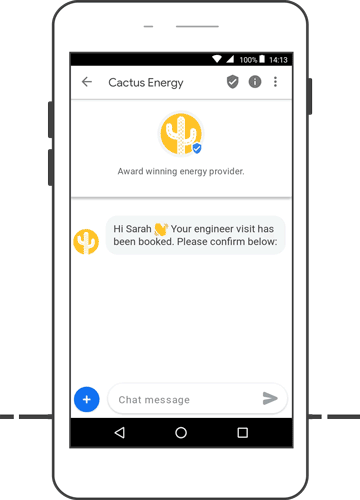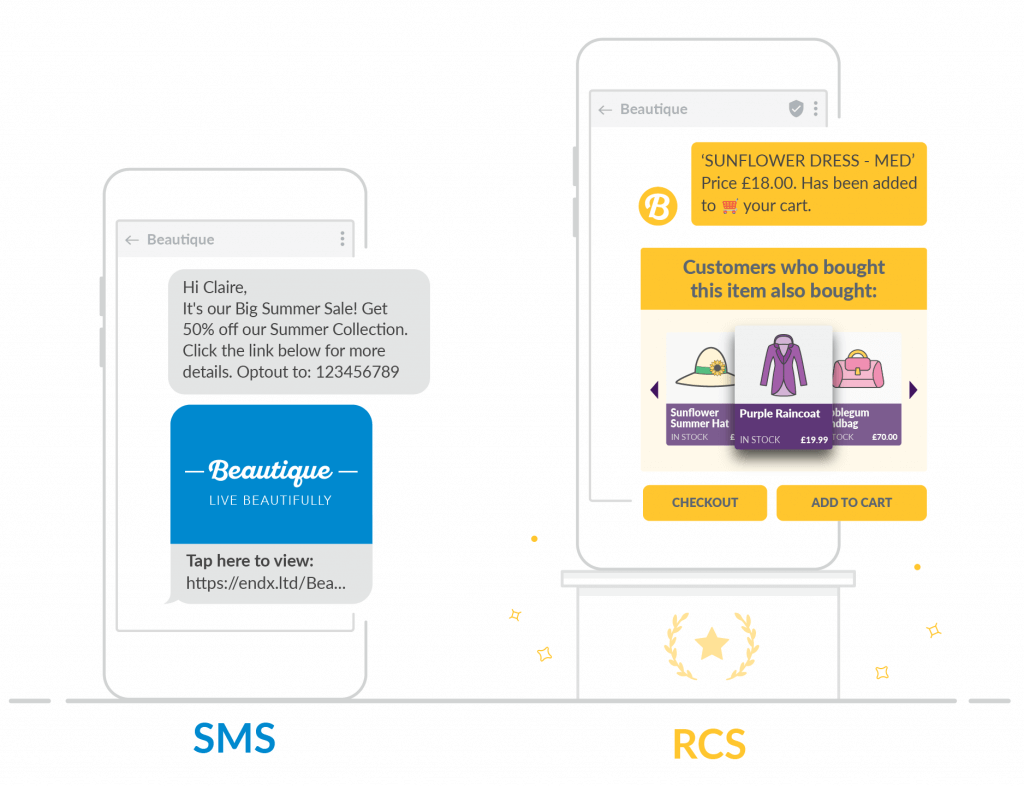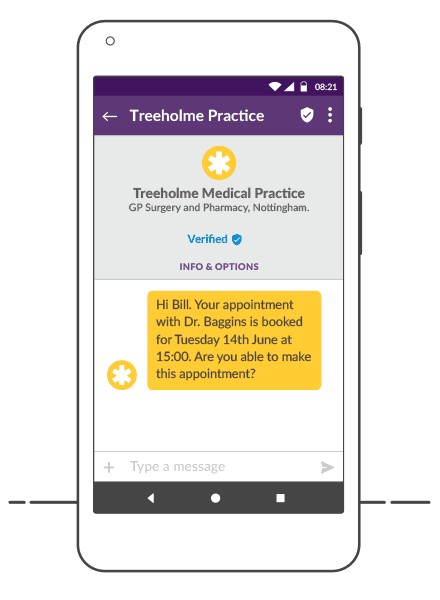SMS offers unrivalled reach and remains a powerful way for businesses to send out quick and effective messages. RCS on the other hand offers enhanced features like branded messages, high-res images, gifs, videos, read receipts and more. Choosing the right messaging channel depends on what your business is trying to achieve.
RCS (Rich communications services) is a type of mobile messaging – offering enhanced features such as multimedia, payment buttons and location sharing. With Apple set to make it available to iPhone users later in 2024, RCS is expected to grow significantly over the coming years.
In 2020, there were 1.2bn users, and research by Juniper predicts there will be 3.9bn by 2025.
Yet, SMS is still relied upon by many to communicate and is a key way for businesses to get messages across to their customers.
So what’s the difference between the two and which channel should you choose to connect with your customers?
We explore all below.
What is RCS (Rich Communication Services)?
RCS capabilities are built into your customers’ mobile devices, so they don’t need to download an app to access it. It’s essentially a richer version of SMS – which is still available alongside it.
Businesses can enhance communications with the use of multimedia like images, videos or GIFS. It’s perfect for brands looking to create impactful content, and enable customers to book appointments or make mobile purchases.
Here’s an example of what an RCS interaction between a business and a customer could look like:

It works on RCS-compatible devices including Android. But if your recipient’s mobile doesn’t support it (Apple devices currently don’t), messages are converted and sent as an SMS.
RCS is secure because messages are sent over the internet and can be encrypted. Businesses also need a verified sender ID when using it, which can help to build trust and credibility.
To learn more, read our complete guide to RCS messaging for businesses.
How is RCS different from SMS?

SMS is perfect for cutting through the noise when it comes to appointment reminders, confirmations, promotions or product recalls. Texts have a 160-character limit, so they need to be snappy, with a clear and compelling call-to-action.
Whereas texts sent on RCS can afford to be more detailed, with up to 25,000 characters.
RCS, like Whatsapp, enables two-way conversation over the internet, and multimedia messaging. Businesses can also send rich cards – including QR codes, barcodes, e-tickets and call-to-action buttons that appear within the app, so customers don’t need to click an external link.
One of the big advantages of RCS is that it creates more opportunities for interaction, engagement and action. This is important given that 53% of people are more likely to shop with a brand that they can reach through a messaging app.
Although RCS offers many advanced features compared to SMS, it is a complementary form of mobile messaging rather than a competitor. SMS is ideal for businesses looking to communicate directly and immediately with customers, and with an open rate of 98%, it remains one of the most effective communication methods out there.
The table below shows a breakdown of the key differences between RCS vs SMS:
| Features | SMS | RCS |
|---|---|---|
| Can be used with other channels | YES | YES |
| Characters allowed in a message | 160 characters | 8000 characters |
| Encrypted | NO | YES (End to end) |
| Read Receipts | NO | YES |
| Verified senders | NO | YES |
| Document sharing | NO | YES |
| Supports encryption | NO | YES |
| Call-to-action buttons | NO | YES |
| Suggested replies | NO | YES |
| Share location | NO | YES |
| Branding (logo and business profiles) | NO | YES |
| Messaging supported on all carrier cellular networks | NO | YES |
| Unlimited message size | NO | YES |
| Share Calendar | NO | YES |
| Rich features (images and videos) | NO (Only using mobile journeys or links) | YES |
If you’re a business weighing up whether to go with RCS or SMS, below we explore some of the key differences and benefits of each in more detail.
What are the benefits of RCS?
Along with a higher character limit and in-app purchases, businesses can include their brand identity across communications to create consistency and trust, and set themselves apart from competitors.
Delivery and read receipts
Read receipts show you when a customer has opened and read a message, which is essential for accountability and tracking.
RCS comes with read receipts so you can see who has looked at the message – which can help you to fine-tune your campaigns. For example, sending RCS in the Esendex platform provides real-time delivery metrics and read receipts so you can optimise as you go and improve ROI.
Verified sender
Businesses who use RCS need a verified sender ID. This helps to prevent fraud and gives customers peace of mind because they know the text is verifiable and far more likely to be legitimate. Your message will include your organisation’s name and branding, to provide reassurance and reduce the risk of customers falling prey to messaging scams.
Include images and videos
Showstopping photography and video can dramatically enhance customer experiences and drive sales. Research suggests that 64% of women shopping for clothes on a mobile are influenced by images – you can tap into this with RCS campaigns!
Share your location
Businesses with a store or those hosting an in-person event can send a map with a pin on to show the location. This makes it easy for customers to find you quickly and helps to build excitement.
Rearrange appointments
Using RCS, customers can change their appointment or add it to their calendar. This is convenient and it means they don’t need to spend time calling a business or waiting in a long call queue. It’s also beneficial for businesses who can reduce high call volumes and the risk of no-shows. Non attendance is said to cost the NHS over £216m per year, and can also be particularly damaging for independent restaurants, hair and beauty salons and garages.

What are the benefits of SMS?
Despite the rise of RCS, SMS remains an invaluable communications tool for everything from marketing (such as promotions, special offers and campaigns) to appointment reminders. High open rates demonstrate its effectiveness in conveying information in the most straightforward way possible.
Accessibility
Concise text messages prevent confusion and include a clear call-to-action which may be to click a link or confirm attendance. SMS has unrivalled reach because over 90% of the global population has a mobile phone which they can receive SMS messages on.
Include links
You can use SMS to send links – which can drive website traffic and conversions. A clear call to action like ‘click now’ – which is direct and won’t confuse customers – increases your chances of someone making a purchase.
Include preview images
SMS doesn’t support pictures but you can include a link that shows a preview image of the website. This visual should entice customers and improve your click-through rate.
Key takeaways
RCS offers many features such as read receipts, multimedia, higher character limits and payment buttons – but SMS for businesses remains as relevant as ever and offers unrivalled reach.
SMS is suited to sending a quick and cost-effective message like an appointment reminder. To build on SMS marketing and engage customers further, businesses can send RCS messages with attractive visuals and more information.
At Esendex we recognise the value of both SMS and RCS. Which one you choose depends on your marketing goals, but it’s important to remember that they work in perfect harmony with each other.
Find out more about how RCS can support your business.


